Despite its small size, the Winged Liberty Head dime, more commonly known as the Mercury dime, might be the most attractive coin the US Mint has ever made. It is very amazing that a coin this little could have such a complex and beautiful design.
Whatever name it goes by, the 1916 introduction of this dime was a pleasant change of pace. Indeed, it symbolized more than intellectual independence; it also represented America’s new spirit, an exuberance reflected in the youth and energy of the nation’s new coinage in the early 1900s.
Keep on reading to find out more about this beautiful piece of history.
What Is the 1939 Mercury Dime Made Of?
The 1939 Winged Liberty Head (Mercury) Dime has a diameter of 17.90 millimeters, weighs 2.50 grams, and has a reeded edge. It has a metal composition of 90% Silver and 10% Copper. Adolph Alexander Weinman designed the coin.
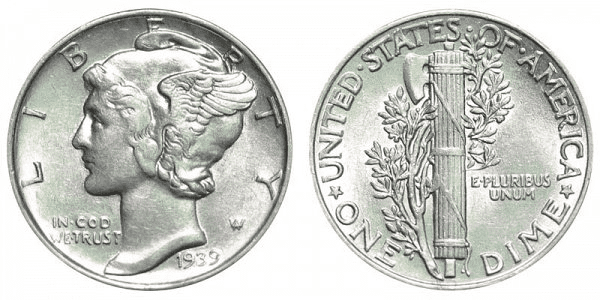
On the coin’s obverse, Lady Liberty donned a Phrygian cap with wings on either side. Because of this particular imagery, many believed it to be the Roman god Mercury. This is where the coin’s famous moniker, Mercury dime, came from.
The stunning design includes the word LIBERTY overarching the design, the year of minting 1939 at the bottom, and the designer’s initials, AW. The well-known saying IN GOD WE TRUST is also inscribed on the left side of the bust’s neck.
On the reverse, you will first see the fasces in the center, which symbolize strength and unity. The universal symbol of peace, the olive branch, is placed around an ax reinforced with a bundle of sticks.
Along the rim of the coin are engraved the words UNITED STATES OF AMERICA along the upper edge and the coin’s denomination, ONE DIME, at the bottom. You can find the coin’s mint mark below the olive branch if available.
1939 Mercury Dime Varieties
Here are the Mercury dime varieties minted in 1939:
| Variety | Mint Location | Mintage |
| 1939 D Mercury Dime | Denver | 24,394,000 |
| 1939 S Mercury Dime | San Francisco | 10,540,000 |
| 1939 P Mercury Dime | Philadelphia | 67,740,000 |
| 1939 Proof Mercury Dime | Philadelphia | 9,321 |
| Total | 102,683,321 |
1939 D Mercury Dime
Year of minting: 1939
Mint Mark: D
Place of minting: Denver
Quantity produced: 24,394,000
Face Value: $0.10 (10 cents)
Price: $2.20 to $6.03 (circulated condition)
Mass: 2.50 grams
Edge: Reeded
Designer: Adolph Alexander Weinman
Composition: 90% silver and 10% copper
Diameter: 17.90 millimeters

From 1937 through 1945, the D-Mint dimes are most frequently found in satisfying condition, and the 1939 D Mercury dime is one of the standout issues. This has proven to be one of the most consistently well-struck and lustrous issues in the Mercury Dime series, and examples are plentiful through the grade of MS-67 FB.
Five repunched mintmarks for the 1939 D Mercury dimes are depicted in “The Authoritative Reference on Mercury Dimes” by John Wexler and Kevin Flynn, though most are fairly small.
The NGC Price Guide estimates that a circulated 1939 Mercury dime is worth between $2.50 and $7.50. However, if you sell your 1939 D Mercury dimes on the open market, you can fetch up to $450, especially if they are in pristine, uncirculated condition!
1939 S Mercury Dime
Year of minting: 1939
Mint Mark: S
Place of minting: San Francisco
Quantity produced: 10,540,000
Face Value: $0.10 (10 cents)
Price: $2.20 to $14.00 (circulated condition)
Mass: 2.50 grams
Edge: Reeded
Designer: Adolph Alexander Weinman
Composition: 90% silver and 10% copper
Diameter: 17.90 millimeters
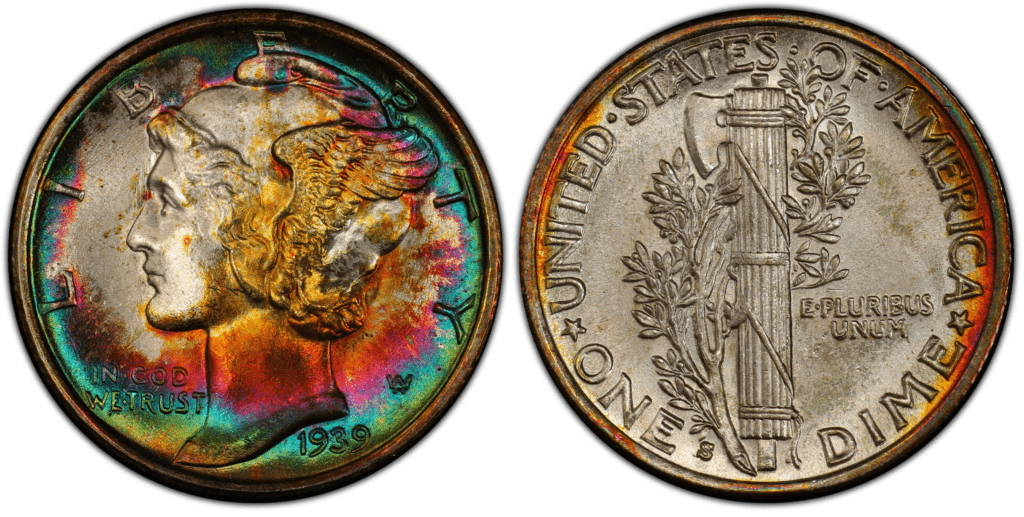
While not particularly uncommon, 1939-S is necessary to finish the “long, short set” of 1934–1945 Mercury Dimes. Compared to other issues from the time period, fewer Mint State specimens appear to have survived. Additionally, a small percentage of individuals viewed have full bands.
On the bright side, 1939 S Mercury dimes are occasionally discovered proof-like to varied degrees, just like most S-Mint dimes from the late 1930s through 1945.
According to the NGC Price Guide on their website, a 1939 Mercury dime’s value is estimated between $2.50 and $17 (January 2023). However, in pristine and uncirculated condition, you could sell this coin for as much as $800 on the open market.
1939 P Mercury Dime
Year of minting: 1939
Mint Mark: No mint mark
Place of minting: Philadelphia
Quantity produced: 67,740,000
Face Value: $0.10 (10 cents)
Price: $2.20 to $5.43 (circulated condition)
Mass: 2.50 grams
Edge: Reeded
Designer: Adolph Alexander Weinman
Composition: 90% silver and 10% copper
Diameter: 17.90 millimeters
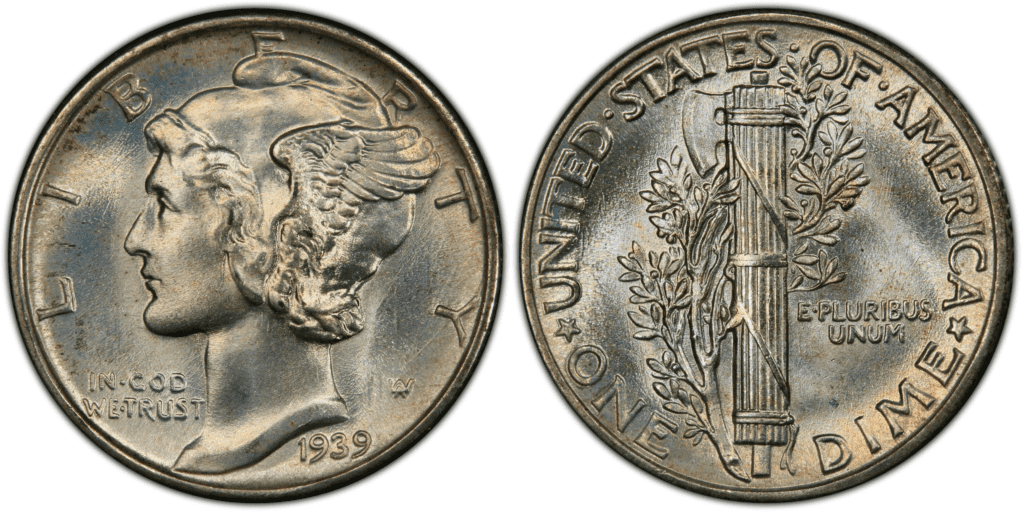
There are plenty of 1939 Mercury dimes on all grades up to MS-67. Unfortunately, Full Bands are frustratingly hard to come by. Since most coins are otherwise well-struck, it is clear that the collar preparation of the die set contained a flaw that prevented metal from filling the die cavity on the majority of coins.
Although the doubled-die obverse variants on this date are plentiful, none are popular enough to garner considerable attention.
A report from the NGC website states that a 1939 Mercury dime’s worth is valued between $2.50 and $7.50 if it is in circulated condition. But if you sell an uncirculated issue in pristine condition on the open market, you could get paid $1250!
1939 Proof Mercury Dime
Year of minting: 1939
Mint Mark: no mint mark
Place of minting: Philadelphia
Quantity produced: 9,321
Face Value: $0.10 (10 cents)
Price: $196 (circulated condition)
Mass: 2.50 grams
Edge: Reeded
Designer: Adolph Alexander Weinman
Composition: 90% silver and 10% copper
Diameter: 17.90 millimeters
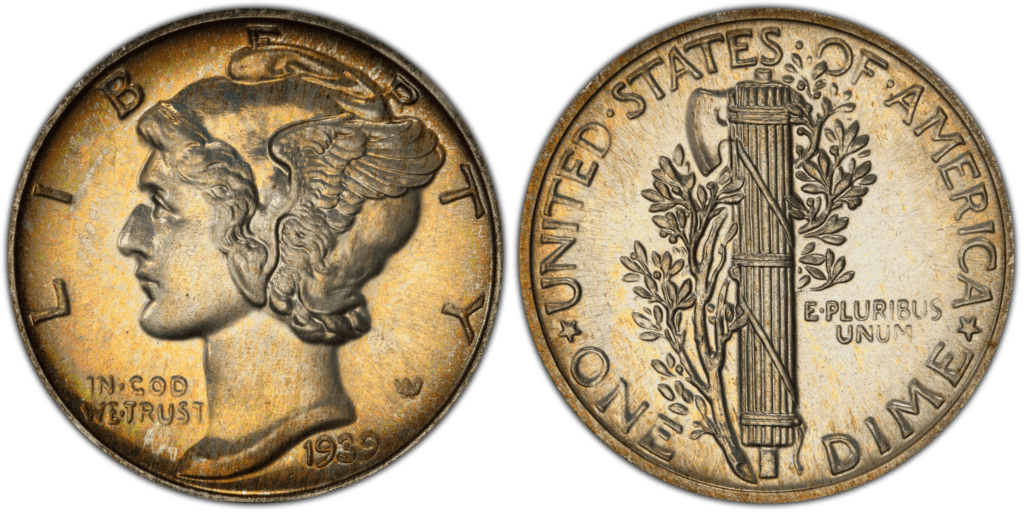
Only a couple thousand pieces are believed to have survived out of the 9,321 proof Mercury dimes produced in the Philadelphia mint in 1939.
As such, it is no surprise that their price ranges from $150 to $500, depending on the level of perfection. Only a few dimes are of PR 68 grade, and purchasing one can cost up to $1,600.
List Of 1939 Mercury Dime Errors
Doubled Die (Obverse) Error
When the die strikes the coin’s design twice or even three times, but at a slightly different angle each time, this is known as doubling. The few 1939 doubled die dime errors that do exist rarely have a significant impression, yet, even these are still valuable to collect.
On the obverse of the 1939 dime, the doubling is most noticeable between the words LIBERTY, the mint year, and the slogan IN GOD WE TRUST. A coin with a doubled die mistake can sell for $40 to $50.
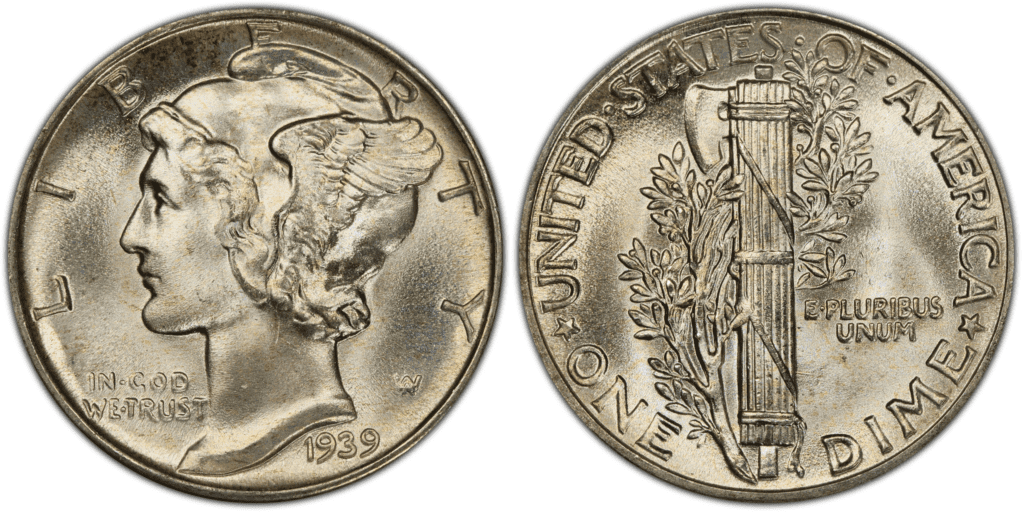
Repunched Mint Mark (RPM)
A doubled, absent, or misplaced mintmark is generally a repunched mintmark. The 1939 dimes struck in Denver, and San Francisco contains several repunched mintmark faults.
Most of these instances are double-struck mints, and a few have a slightly off-center mintmark. The price of the 1939 repunched mint mark dime faults ranges from $20 to $25, it could go higher depending on how much of the mint mark has been doubled or misaligned.
How Much Is The 1939 Mercury Dime Worth Today?
According to the USA Coin Book, the 1939 D Mercury dime is estimated at $2.77 in Average Condition and can be worth up to $32 or more in Uncirculated (MS+) Mint Condition.
The USA Coin Book also estimated the 1939 S Mercury dime to be valued at $2.77 in average condition. It can cost up to $48 or more in uncirculated (MS+) mint condition.
However, the 1939 Mercury dime from the Philadelphia mint has an estimated value of $2.77 in Average Condition and can be worth up to $28 or more in Uncirculated (MS+) Mint Condition. Proof coins from the same mint have a value of up to $455.
Take a look at this table of auction records for each variety to have a better idea of how much the 1939 Mercury dime can be:
| Coin | Condition | Grade | Sold date | Sold by | Value |
| 1939 D Mercury Dime | Superb Gem Uncirculated – Full Band | MS 69 | August 26, 2019 | Legend Rare Coin Auctions | $42,300 |
| 1939 Proof Mercury Dime | Gem Uncirculated – Proof | PR 68+ | December 8, 2022 | Heritage Auctions | $21,600 |
| 1939 P Mercury Dime | Superb Gem Uncirculated | MS 68 | August 6, 2000 | Heritage Auctions | $12,650 |
| 1939 S Mercury Dime | Superb Gem Uncirculated | MS 68 | October 1, 2000 | Heritage Auctions | $10,350 |
How Coins are Graded
The Sheldon Scale is used by numismatists to provide a numerical value to coins. The Sheldon Scale goes from poor (P-1) to perfect mint state (P-1) (MS-70). Coins were originally evaluated using words to reflect their condition (Good, Fair, Excellent, Etc.). Unfortunately, coin collectors and dealers had different ideas about what each of these terms represent.
Professional numismatists joined together in the 1970s and established CoinGrading standards. These numismatists now assign grades at key places on the seventy-point scale, using the most regularly utilized numeric points in conjunction with the original adjective grade. The following are the most common coin grades:
- (P-1) Poor – Indistinguishable and probably damaged; if used, must have a date and mintmark; otherwise, rather battered.
- (FR-2) Fair – Nearly smooth, but without the damage that a coin graded Poor often possesses. The coin must have enough detail to be identified.
- (G-4) Fair – Inscriptions have merged into the rims in some areas, and important elements have been mostly erased.
- (VG-8) Very Good- A little weathered, but all of the primary design elements are visible, albeit faintly. There is little if any, central detail left.
- (F-12) Good – The item is very worn, yet the wear is even, and the overall design details stand out clearly. Rims are almost completely isolated from the field.
- (VF-20) Very Fine – Moderately weathered, with some finer features still visible. The motto or all letters of LIBERTY are readable. Both sides of the coin have entire rims that are separated from the field.
- (EF-40) Extremely Fine – Gently used; all gadgets are visible, and the most important ones are bold. The finer details are bold and clear, however, light wear may be seen.
- (AU-50) Uncirculated – Slight evidence of wear on the coin’s design’s high points; may have contact marks; eye appeal should be adequate.
- (AU-58) Uncirculated Choice – Slight traces of wear, no severe contact marks, almost full mint shine, and great eye appeal.
- (MS-60) Mint State Basal – Strictly uncirculated; no indication of wear on the coin’s highest points, but an unsightly coin with reduced luster, visible contact marks, hairlines, and other flaws.
- (MS-63) Mint State Acceptable – Uncirculated, but with contact scratches and nicks, little reduced shine, but otherwise appealing appearance. The strike is weak to average.
- (MS-65) Mint State Choice – Uncirculated with great mint shine, very little contact blemishes, and exceptional eye appeal. The strike is unusually severe.
- (MS-68) Mint State Premium Quality – Uncirculated with superb luster, no obvious contact marks to the naked eye, and exceptional eye appeal. The strike is quick and appealing.
- (MS-69) Almost Perfect Mint State – Uncirculated with perfect brilliance, a sharp and appealing strike, and extremely good eye appeal. A near-perfect coin with minor imperfections in the planchet, strike, and contact markings (seen only under 8x magnification).
- (MS-70) Mint State Perfect – Under 8x magnification, there are no tiny imperfections discernible; the strike is crisp, and the coin is perfectly centered on a beautiful planchet. Rarely seen on a coin, this coin is bright and whole, with original luster and exceptional eye appeal.
Where To Buy Or Sell 1939 Mercury Dime?
Even though it is more difficult, you might be able to find a 1939 Mercury dime in a coin or antique shop. But because of technology, searching online for locations where you can easily buy these coins is now possible.
To look for 1939 Mercury dimes, check out online marketplaces and auction sites like Amazon, eBay, Etsy, or Craigslist. You might even be fortunate and come across a vendor with a rare one!
You can also seek guidance from experts in coin grading services like the Numismatic Guaranty Company (NGC) or the Professional Coin Grading Service (PCGS) if you want to be certain of your purchases. These organizations can provide information on how to purchase or sell your 1939 Winged Liberty Head (Mercury) dimes.
FAQs
Where is the mint mark on the 1939 Mercury dime?
You can find the coin’s mint mark below the olive branch on the coin’s reverse side. The coins produced at the Philadelphia mint do not bear any mint mark.
Is a 1939 Mercury dime worth anything?
The USA Coin Book estimated the 1939 S Mercury dime to be valued at $2.77 in average condition. It can cost up to $48 or more in uncirculated (MS+) mint condition. According to the NGC Price Guide, a 1939 S Mercury dime in pristine and uncirculated condition can be sold for as much as $800 on the open market.
